Are you wondering what the value of a 1946 nickel is? Well, right off the bat, I can tell you that it’s worth more than 5 cents. However, the exact value is determined by the grading, mintmark, and any errors. This article is a 1946 nickel value guide, with information on the different grades and values of the coin.
1946 Nickel: Grades and Values
The 1946 nickel is a fairly common coin. The value of circulated grades ranges from $0.1 to $0.9, while mint-state uncirculated grades cost between $1 to $15. The highest-valued nickels are the brilliant uncirculated coins from MS65, which you can get for $22 to $100.
| 1946 Nickel: Grade and Value Chart | |||
| Grade | 1946 No-mint mark | 1946-D Nickel | 1946-S Nickel |
| Extremely fine (20) | $0.30 | $0.30 | $0.40 |
| About Uncirculated (50) | $0.8 | $0.8 | $1 |
| Mint state (60) | $2 | $1 | $2 |
| FS mint state (60) | $10 | $2 | – |
| Brilliant mint state (65) | $26 | $22 | $22 |
| FS Brilliant mint state (65) | $100 | $30 | $50 |
1946 Jefferson Nickel: History and Facts
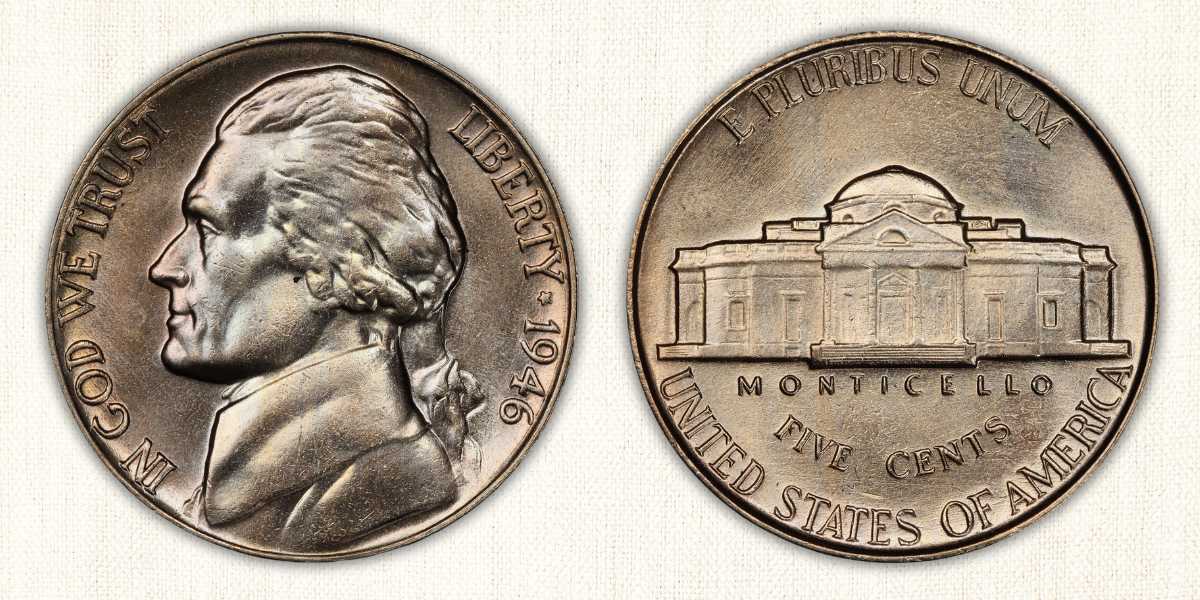
The 1946 nickel had a total mintage of 219.9 million coins from three different mints; Philadelphia, Denver, and San Francisco.
This coin is the 9th nickel in the Jefferson series designed by Felix Schlag in honor of the 3rd US President. It features the image of Thomas Jefferson on the obverse and his Monticello estate on the reverse. The coins have a plain edge, 21.1mm diameter, and weigh 5.0 g.
The 1946 Nickel was released the year after World War two. It was the first nickel in 3 years that was actually made with nickel, and marked the return to the original 75% copper–25% nickel composition.
The previous three years had seen the 5-cent coins made with silver rather than nickel. This was because the US congress had ordered all nickel to be removed from coins and instead used for munitions for the war efforts.
But when the war ended, there was no military need for nickel, so it was reintroduced into 5-cent coins, starting with the 1946 Jefferson Nickel.
However, the war had taken a toll on the country’s finances, and budgets were slashed for several federal agencies, including the Mint. As a result, the quality of these coins was not as good as the pre-war nickels, even though they had the same composition.
1946 Jefferson Nickel: Regular Strike and Full Steps
Coin grading organizations grade Jefferson nickels based on the appearance, tone, and shine of the coin. And whether or not the coin has full Steps.
Full steps is a designation that’s used only for Jefferson nickels. It refers to the series of steps at the base of the Monticello building on the reverse side of the coin.
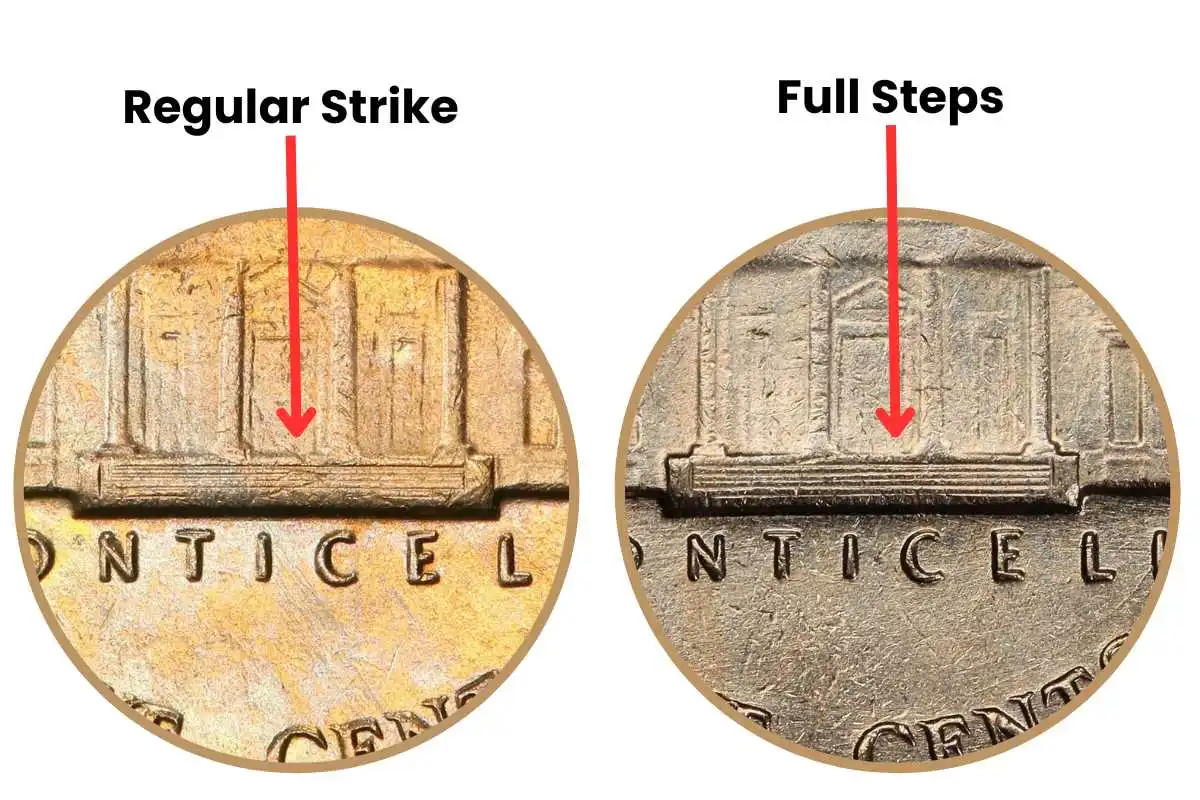
1946 full steps nickels command the most value and are very sought after by collectors and numismatists.
But for a coin to be graded as Full steps, it must have at least five clear and distinguishable and unmarred lines on the steps at the base of Monticello. Additionally, only coins graded at MS60 and above can be called full steps. But don’t mistake this to mean that all Mint-state Jefferson cents are full steps, because most are not.
Despite the low quality of 1946 nickels, there are a considerable number of mint state coins with Full Steps. At MS60 to MS65, full step 1946 cents cost $10 to $80 more than non-full steps.
Things take a sharp turn at the higher grades of MS67 and MS67+, as full steps coins of these grades become scarce. As a result, the difference is at least $2,000.
1946 No Mint Mark (P) Nickel: Value and Grading

After the war, the Philadelphia Mint produced over 116 million nickels, which was by far the largest production of the three Mints.
Circulated specimens are pretty common. The lowest grades are valued at $0.10, just a few cents more than the face value. The value rises slowly through the uncirculated grades, till it gets to $1 for an “about circulation” coin.
Even mint-state coins are common, and you can easily get an MS60 for $2, while a less common MS65 will cost you $26. At MS66, the coins become scarce and the value increases to $42, and an MS67 is worth $600.
Full steps are also plentiful, though not as common as ordinary MS coins. At low-mint state grades, MS60 with full steps goes for $10, and MS64 goes for $40. But At MS65, full steps start becoming scarce, and there is a sharp rise in value to $100 for a 1946 MS65 nickel with full steps.
The price spikes further at MS66 and above, where the Full Steps coins at this grade are truly scarce.
A 1946 MS66 full steps nickel is worth $775, a further increase in grading to MS67, will more than triple the value to $6,000.
The value of 1946 (P) nickel is even higher at auctions. The current record is $8,812 for a full steps MS67 nickel sold by Legend Rare Coin Auctions in March 2020.
| 1946 No Mint (P) Nickel: Grade and Value Chart | ||
| Grade | Regular Strike | Full Steps (FS) |
| Extremely Fine (40) | $0.30 | – |
| About Uncirculated (50) | $1 | – |
| MS 60 | $2 | $10 |
| MS 61 | $3 | $11 |
| MS 62 | $4 | $12 |
| MS 63 | $10 | $25 |
| MS 64 | $15 | $40 |
| MS 65 | $26 | $100 |
| MS 66 | $42 | $775 |
| MS 66+ | $110 | $1200 |
| MS 67 | $600 | $6,000 |
1946-D Nickel: Grading and Value
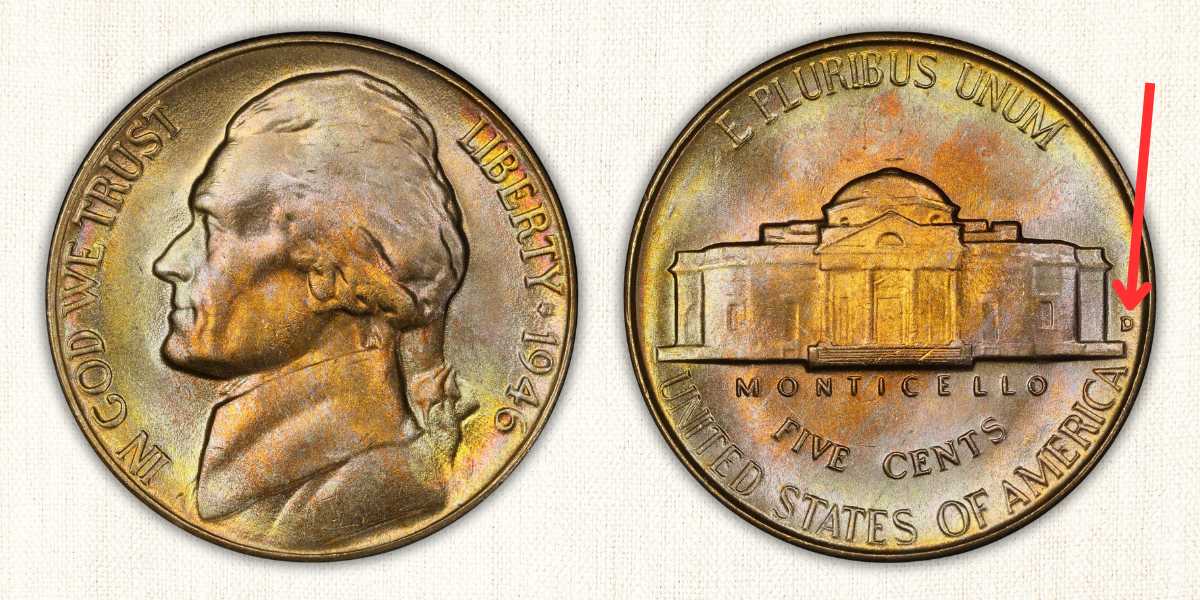
The Denver Mint also minted nickels after the war. These had the customary D mint mark beside the Monticello. All in all, there were approximately 45.3 million of these D nickels released in 1946.
Though its mintage is less than half of that of Philadelphia, the 1946-D nickels are still common in circulated grades. The prices start at $0.10 for the lowest grades and finish at 0.80 for the highest circulated grade, AU50.
Mint-state 1946-D nickels are also fairly common, so there is no significant increase in the price of low-grade MS coins. For instance, an MS60 goes for $1, an MS62 is worth $3 and an MS65 goes for $22.
Even higher MS grades of the 1946-D Jefferson nickels are readily available, so there are no dramatic increases in the prices. MS66 costs $32 and MS67 costs $175. But a slight increase to MS67+ triples the value to $800, as this grade is difficult to come by.
Full steps 1946-D nickels are not much different from the ordinary MS nickels. You can get an MS60 with full steps for $2, and an MS66 for $70. Only the rarest MS67 and MS67+ full steps are at $650 and $2,600 respectively, and have a much higher value compared to non-full steps coins of the same grade.
Not surprisingly, the most expensive 1946-D nickel is an MS67 full step sold by Auctioned by Heritage Auctions for $5,405 in May 2007.
| 1946-D Nickel: Grade and Value Chart | ||
| Grade | Regular Strike | Full Steps (FS) |
| Extremely Fine (40) | $0.30 | – |
| About Uncirculated (50) | $0.90 | – |
| MS 60 | $1 | $2 |
| MS 61 | $1 | $2 |
| MS 62 | $3 | $3 |
| MS 63 | $4 | $10 |
| MS 64 | $12 | $22 |
| MS 65 | $22 | $30 |
| MS 66 | $32 | $70 |
| MS 67 | $175 | $650 |
| MS 67+ | $800 | $2,600 |
1946-S Nickel: Grading and Value
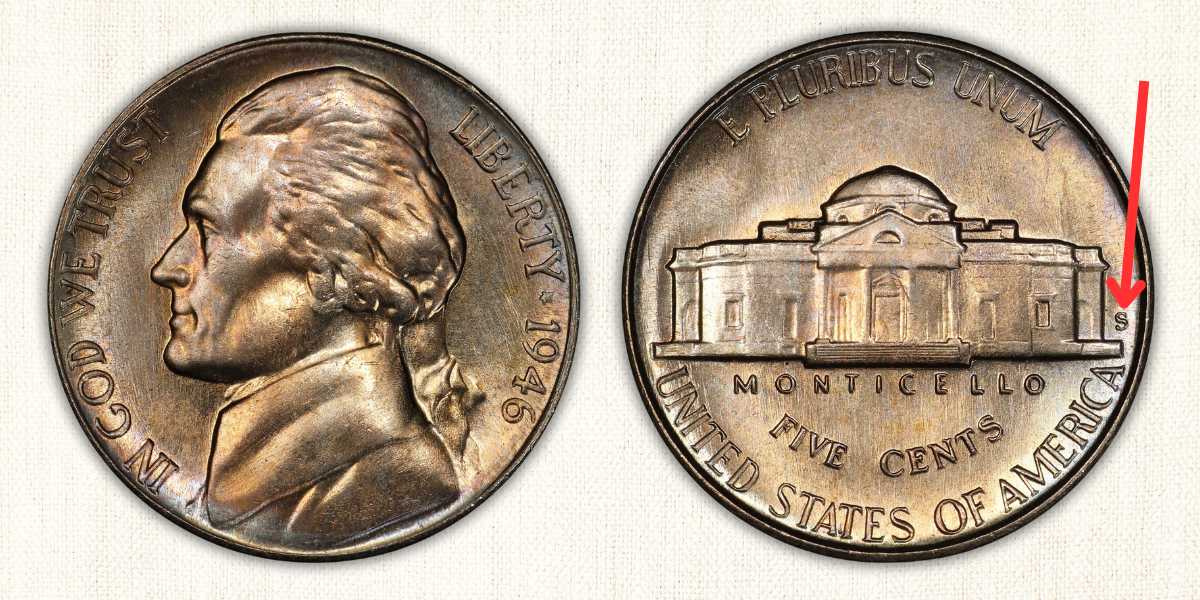
The San Francisco mint typically makes the least number of coins, and in 1946 it produced about 13.5 million nickels.
While the 1946-S nickels are not exactly scarce, they aren’t as common as the Philadelphia or Denver nickels. But that doesn’t have any real impact on the value of these S nickels. The prices are very similar to the other mint marks, valued at $0.10 to $1 for circulated coins.
Uncirculated 1946-S nickels also start at $2. You can get an MS65 for $22, and an MS67 for $215. Again, these prices are similar to 1946-D and 1946 (P) nickels.
The only time the prices diverge is at higher grade full steps coins. A 1946-S MS67 full steps nickel is worth $7,000 and an MS67+ can be worth $25,000. These amounts are at least 5 times the value of high-grade full steps of the other Mints, making the 1946-S the costliest nickel of 1946.
But despite having the title of costliest nickel, the auction record for the 1946-S is a modest $7,800 for a full steps MS67 nickel sold by Heritage Auctions in 2017.
| 1946-S Nickel: Grade and Value Chart | ||
| Grade | Regular Strike | Full Steps (FS) |
| Extremely Fine (40) | $0.40 | – |
| About Uncirculated (50) | $1 | – |
| MS 60 | $2 | – |
| MS 61 | $2 | – |
| MS 62 | $3 | – |
| MS 63 | $8 | $15 |
| MS 64 | $14 | $40 |
| MS 65 | $22 | $50 |
| MS 66 | $34 | $275 |
| MS 67 | $215 | $7,500 |
| MS 67+ | $850 | $25,000 |
1946 Jefferson Nickel Error Coins
The Philadelphia Mint appears to have produced more error coins than the other Mints. Of course, you can attribute part of this to the higher mintage. But even at that, the Philadelphia coins weren’t as good as the 1946 Denver nickels.
Most errors were related to the planchet, such as splits, lamination errors, and strikes on the wrong planchet, including those struck on wartime planchets.
1946 Jefferson Nickel – Struck on Wartime Planchet

This 1946 (P) nickel was struck on a leftover wartime silver planchet.
The coin has the distinct silver patina that war-era nickels have. But besides that, there are no visible defects and the designs and lettering are all correct. And if the date was different, this would have been a perfectly error-free wartime nickel, but for 1946, it’s an error.
This is a rare error, and such coins are very valuable. For instance, this coin is circulated and quite worn, with a PCGS grading of F12, but it is still worth an impressive $9,600.
1946 Jefferson Nickel with Split Planchet Error
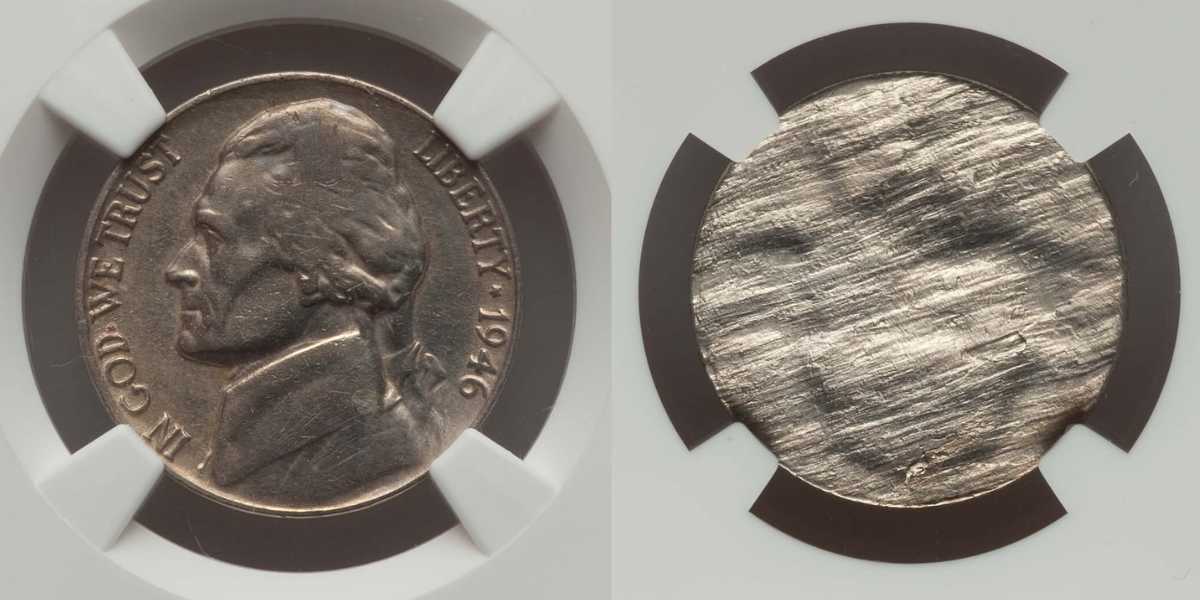
This circulated Philadelphia 1946 Jefferson Nickel has a rare split Planchet error.
Split Planchet errors happen due to deep internal laminations. Impurities or gas bubbles in the alloy prevent proper bonding and may create a layer of weakness in the metal. The lamination can cover an entire layer, making the coin split into two halves at the slightest touch or impact.
In the case of this 1946-D Jefferson, the coin split after the strike, on the flip side, you can see the striations where the coin split, and there’s a vague impression of Jefferson’s image.
The coin weighs 2.7g (full coins weigh 5.0g) and is valued at $42.
1946 Jefferson Nickel with Obverse Lamination Error

Here we have a 1946 no-mint mark nickel with a lamination error on the obverse.
The spot right under Jefferson’s chin appears to have peeled off. This type of error results from impurities and gas bubbles in the alloy.
The coin is circulated, and despite the defect, it is priced at $250.
1946 P Nickel with Planchet Clip Error
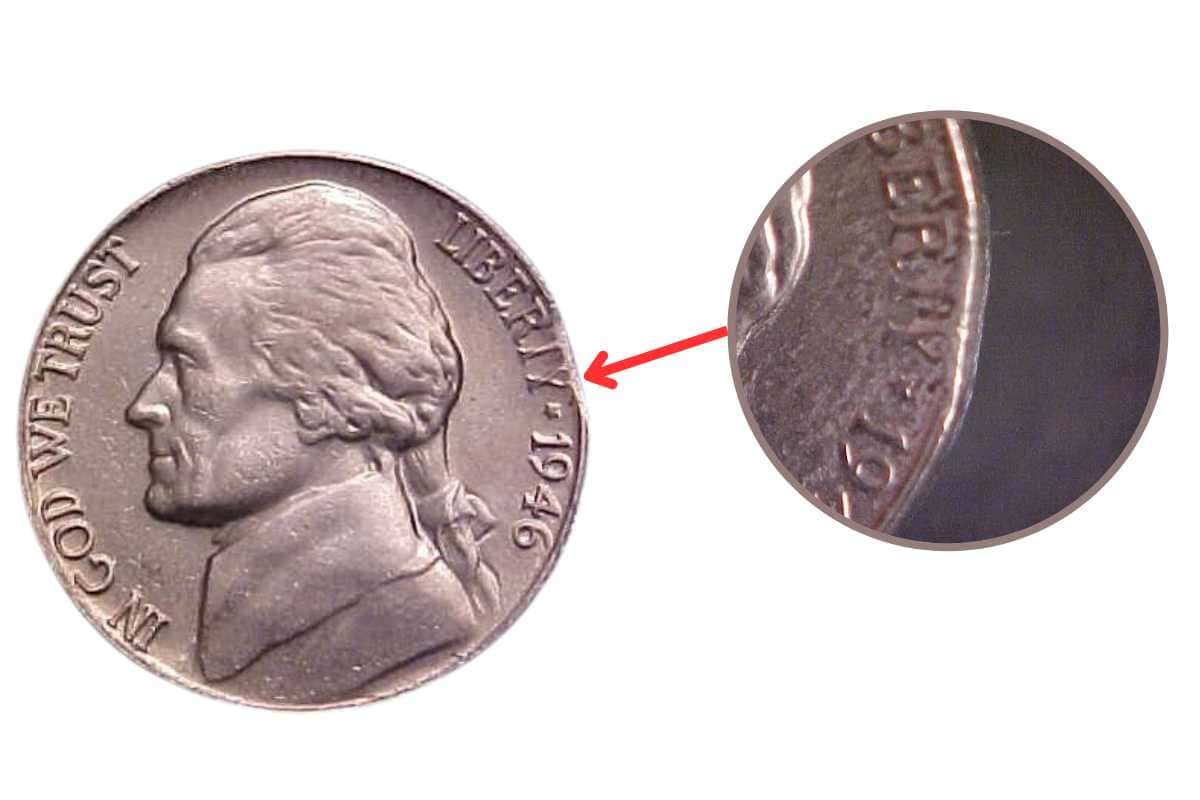
This is a 1946 (P) nickel with a minor planchet clip error.
On the obverse, the error affects the last letters of the word “LIBERTY.” On the reverse, the clip barely touches the last letter in “AMERICA.”
Clip errors like this arise during the planchet-making process. A punching die overlaps a previously punched hole in the metal strip, resulting in a clip at the point of the overlap.
This particular coin hasn’t been professionally graded, but you can tell that it’s a circulated coin in fairly good condition. It is priced at $10.68.
1946 5C Jefferson Nickel with Struck on Penny Planchet Error
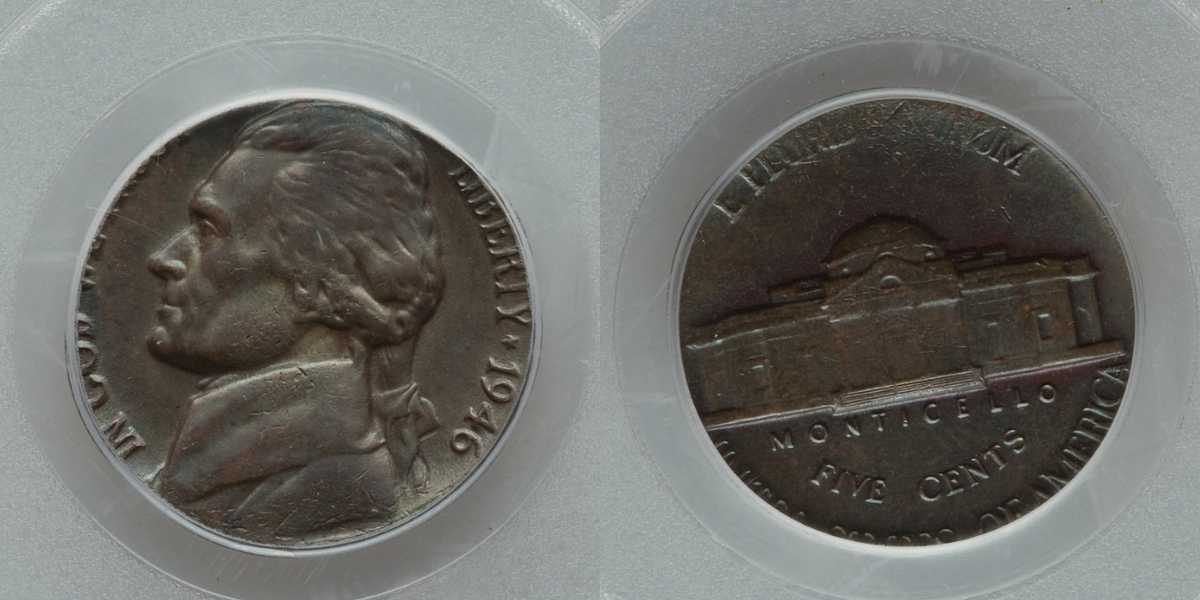
This is a circulated no-mint mark 1946 Jefferson coin with a rare error–it was struck on the wrong Planchet. As a result, this coin has a different composition, size, and appearance from other 1946 nickels.
Since pennies have a smaller diameter than nickels, some details of the nickel, especially the lettering on the outer edge, do not appear on the coin.
On the obverse, much of the “IN GOD WE TRUST” motto isn’t captured on the coin. Similarly, on the Reverse, the same thing happens to the “UNITED STATES” lettering.
The cause of this error is fairly obvious: the wrong planchet was put in the nickel dies. The coin is PCGS graded as MS65BN and worth $840.
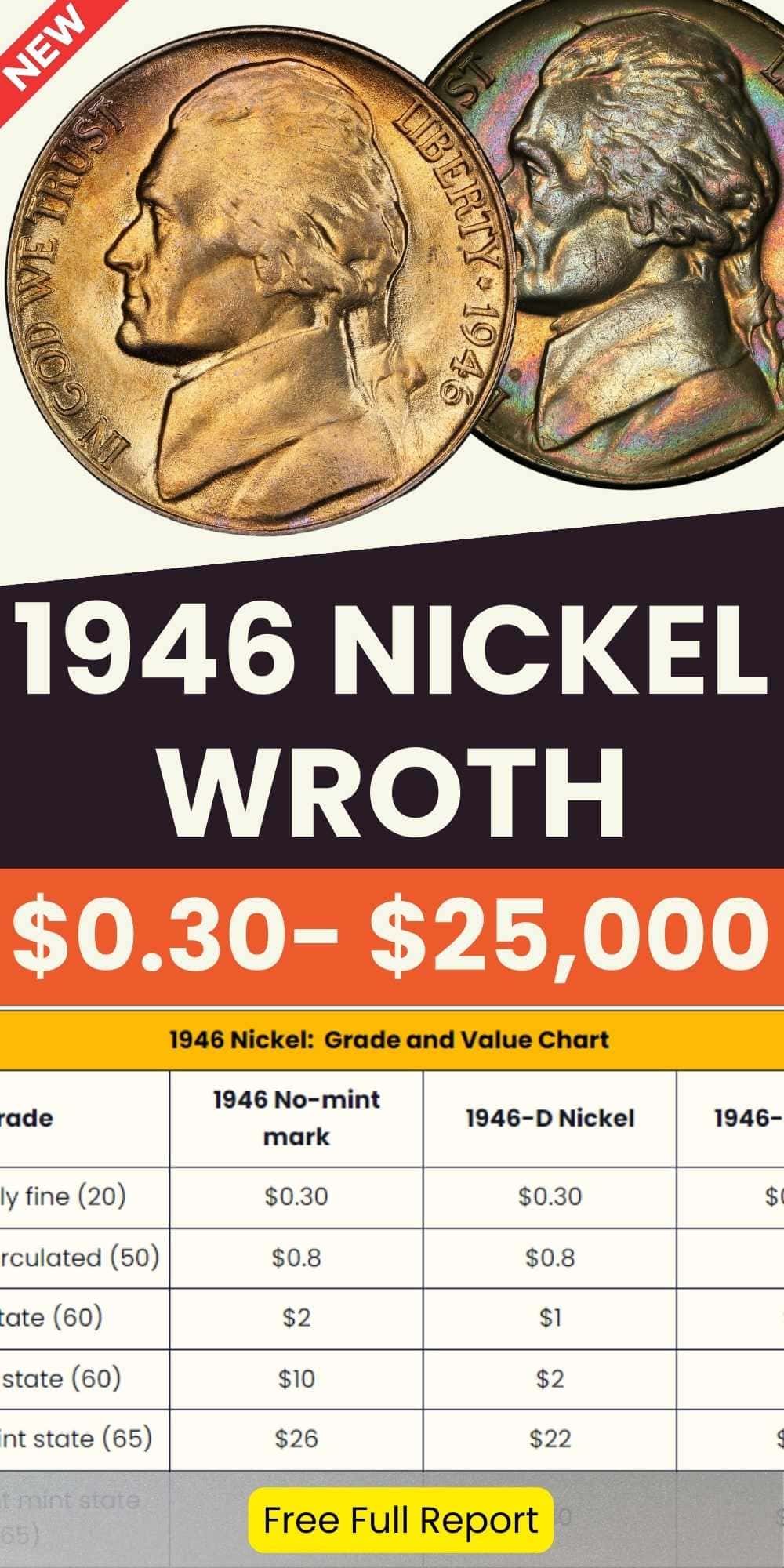

Jenson is a professional numismatist, a dedicated coin collector, a graduate of the College of Business at Oregon State, a life member of the American Numismatic Association (ANA), and an overall coin nerd. He is the founder of Coin Value List.
